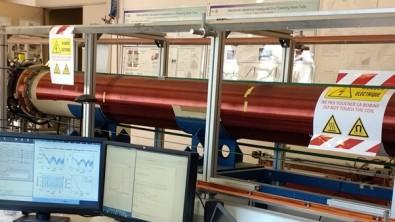The study could help upgrade satellite communications equipment

Credit: Meirielen Caetano de Sousa/USP
A paper on research conducted by Meirielen Caetano de Sousa, postdoctoral fellow at the University of São Paulo’s Physics Institute (IF-USP) in Brazil, is highlighted as Editor’s Pick in the September issue of Physics of Plasmas, published by the American Institute of Physics with the cooperation of The American Physical Society. The paper, entitled “Wave-particle interactions in a long traveling wave tube with upgraded helix”, is signed by Sousa, Iberê Caldas, her supervisor at IF-USP, and collaborators at Aix-Marseille University in France, where Sousa served a research internship with the support of a scholarship from FAPESP (São Paulo Research Foundation) and CAPES, the Brazilian Ministry of Education’s higher research council.
The focus of Sousa’s research was an experimental study of electron-plasma interactions. Because plasma is a medium with substantial background noise, analogous conditions to those of plasma were simulated in a vacuum by the use of short electromagnetic waves propagating in a traveling wave tube or TWT.
“TWTs are devices in which electromagnetic waves interact with electron beams,” Sousa explained. “Industrial TWTs are between 2 cm and 30 cm long and are mainly used to amplify radio frequency signals in space communications. The TWT at Aix-Marseille University is 4 m long and specially designed for research in plasma physics with a very low level of noise. It’s currently the only one of its kind in operation in the world.”
The waves are produced at frequencies ranging from 10 to 100 megahertz (the intermediate region of the radio band of the electromagnetic spectrum) by a waveform generator and propagate through a helix coupled to the horizontal axis of the TWT. The helix has recently been upgraded to make it as regular as possible. Sousa took part in the upgrade, and her study would not have been possible without it. In its previous configuration, the TWT was less precise owing to small variations in the pitch of the helix and hence in the waveform generated.
“In the first part of the study we analyzed wave propagation without the electron beam,” Sousa said. “We found excellent agreement between the theoretical predictions and the experimental data. This means both that the theoretical model was producing accurate predictions and that the device was working perfectly.”
But the really important findings were produced in the second part, which consisted of an investigation of the interaction between the electromagnetic wave and the electron beam. “We observed the energy exchange between the wave and the electrons,” Sousa said. “The electrons travel slightly faster than the wave’s phase velocity and transmit this kinetic energy differential to the wave, increasing its amplitude. When the wave reaches maximum amplitude, it starts to oscillate, rising and falling, and the electrons are trapped in the wave potential, with their velocities varying around the velocity of the wave phase. They transfer energy to the wave and then receive energy from the wave.”
For low values of electric current, she added, the phenomenon matches the linear theory predictions, but when current values are high the electrons interact not only with the wave but also with each other. This results in non-linear effects no longer aligned with theoretical predictions.
“Studying these effects is one aim of the future experiments we’re planning,” Sousa said. “Another is studying non-monokinetic beams, in which the electrons travel at different velocities, and the interaction between these beams and a broad wave spectrum, meaning several waves that propagate at the same time inside the device.”
The completed study and the planned experiments are in the field of basic science, investigating the accuracy of the frontier theory and phenomena not yet described adequately by the theoretical model. Possible technological applications are on the horizon, however. “A more immediate application would be upgrading of industrial TWTs. A more ambitious one would be contributing to upgrades of other devices that use the interaction between electromagnetic waves and electrically charged particles, such as particle accelerators, for example,” Sousa said.
In addition to the research internship abroad scholarship awarded to Sousa, FAPESP supported the study via a direct doctorate scholarship and a postdoctoral fellowship, also awarded to Sousa; and a Thematic Project on “Non-linear dynamics”, led by Caldas.
###
About São Paulo Research Foundation (FAPESP)
The São Paulo Research Foundation (FAPESP) is a public institution with the mission of supporting scientific research in all fields of knowledge by awarding scholarships, fellowships and grants to investigators linked with higher education and research institutions in the State of São Paulo, Brazil. FAPESP is aware that the very best research can only be done by working with the best researchers internationally. Therefore, it has established partnerships with funding agencies, higher education, private companies, and research organizations in other countries known for the quality of their research and has been encouraging scientists funded by its grants to further develop their international collaboration. You can learn more about FAPESP at http://www.
Media Contact
Joao Carlos Silva
[email protected]
Original Source
http://agencia.
Related Journal Article
http://dx.




